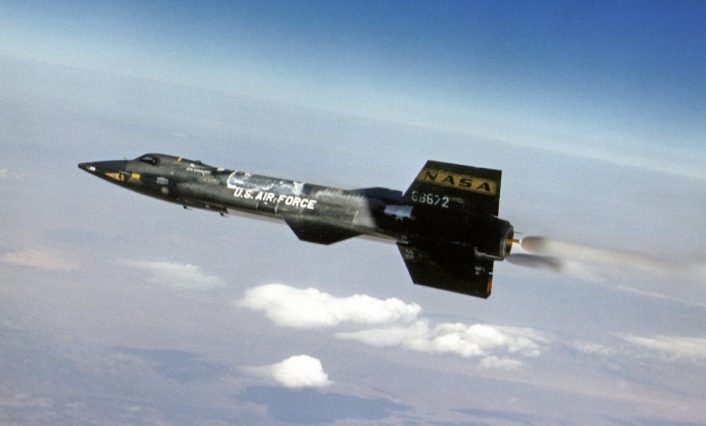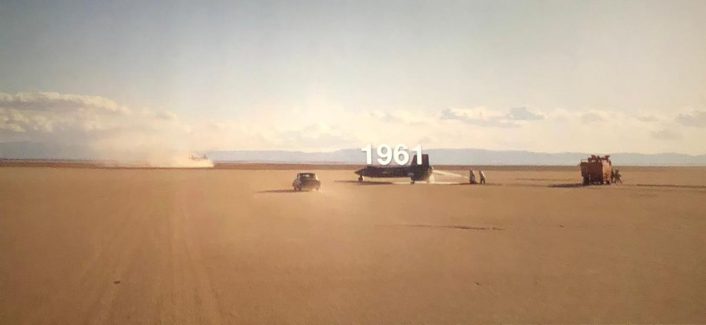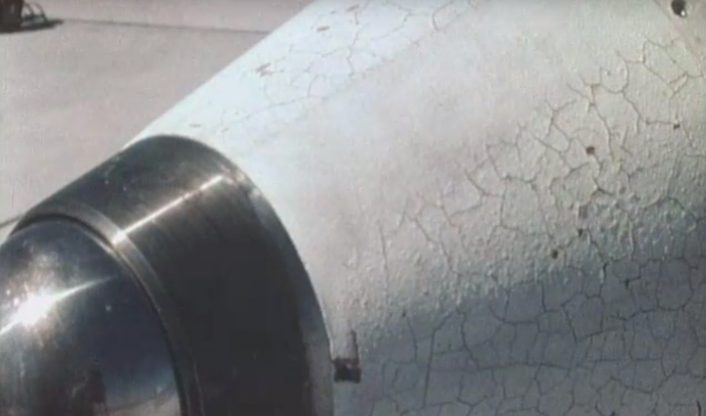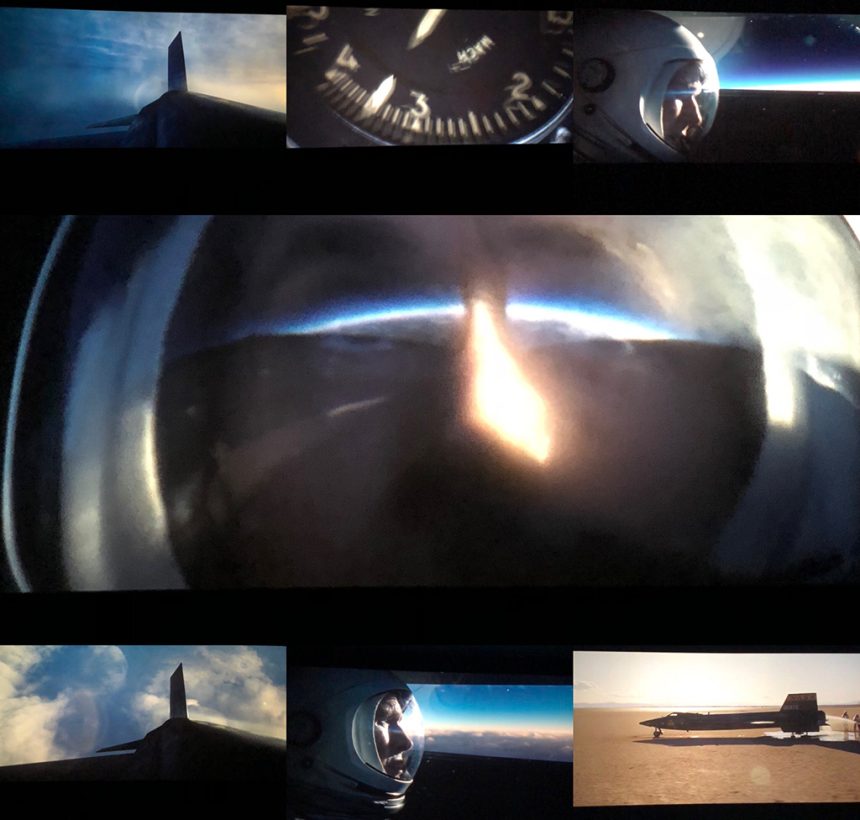There is much more in Neil Armstrong’s flight, the longest X-15 flight in the entire research program, than a movie can show.
If you haven’t done it already, I would suggest you to reserve a few hours and watch “First Man”.
The movie opens with a pretty intense scene showing Neil Armstrong (Ryan Gosling) piloting a North American X-15 during a test flight. Although the hypersonic rocket-powered research aircraft built in three examples and capable of Mach +6 speed appears only for a few minutes at the beginning of the movie, I think most of our readers will find it interesting to know something more about the opening scene’s flight.
Beware: spoilers ahead.
The first question that came to my mind during the movie were: what was the goal of that test flight? and, did the test go exactly as depicted in the movie?
In order to find an answer to these questions I asked some help to Paul Raveling, who runs an extremely insightful website at sierrafoot.org, with a section completely dedicated to the X-15 Hypersonic History. I was already in contact with Paul, who had provided a lot of interesting information about Delamar Dry Lake and the other emergency landing sites for the X-15, so it was natural to me to ask him for additional details.

Let’s start from the very beginning. The so-called “Neil Armstrong’s reentry skip” was flight “3-4-8” on Apr. 20, 1962.
Flight “3-4-8” means these three things:
- X-15 #3 (USAF contract & tail number 56-6672)
- 4th free flight of this X-15 (#3)
- 8th flight of this X-15, counting all three types of flights: Free flights (launched), captive carries, and aborts (not launched, returned to landing by the B-52 )
“On my web page I also called it Flight 51, the 51st X-15 free flight, but 3-4-8 is the proper designation. Neil Armstrong noted that point when I exchanged email with him for his review of that flight’s page on sierrafoot.org. Being correct and precise goes with the job in engineering, and Neil was well qualified as an engineer,” says Raveling in an email.
“Flight 3-4-8, which was the first one I documented on sierrafoot.org”, he explains. “Despite plans to document at least a couple dozen “X-15 adventure” flights, I got busy with other things after doing only that one flown by Neil and the first X-15 free flight, the glide flight flown by Scott Crossfield. There’s also a PowerPoint presentation for Bob White’s FAI world altitude record flight. The center of that presentation follows the flight in real time: It took 10 minutes 20.7 seconds from launch to touchdown, covered about 315 miles horizontally and 110 miles vertically. It’s challenging to narrate that, someday soon I should record narration in the PowerPoint file.”
“Flight 3-4-8’s major lasting legacy was that it changed the plan for how to do winged reentries safely from orbit. In trying for a planned test point for G limiting by the MH-96 that didn’t work, Neil demonstrated that maneuvering vertically can very easily produce a skip off the aerodynamically usable atmosphere and loss of control at a critical time. That X-15 flight triggered changing plans for how the then-future Space Shuttle would do reentry energy management — the “skip” risk was eliminated by using roll reversals. There’s a follow-on story about how we nearly lost Columbia on STS-2, in an automated reentry. Because of the time required for a fix to go through software QA, ex-X-15 pilot Joe Engle flew that reentry manually — the only time it was done in Shuttle history. (Some web sources whose authors are unaware of that exception say incorrectly that the Shuttle never flew a manual reentry.)”

This page on Paul’s website provides tons of information and geeky details about that mission, including the pilot’s report.
First of all, it lasted 12 min. 28.7 sec: the longest X-15 flight of the entire research program. The rocket burned for 82.4 sec and the maximum speed the X-15 reached is Mach 5.31. The peak of the test flight was at 207,500 feet. Then, flight 3-4-8 was the first flight using the ball nose (“q-ball” air data sensor), and initial checkout of the MH-96 flight controller. Here’s what does this mean according to what reported at sierrafoot.org:
The MH-96 was an experimental adaptive controller on the #3 X-15. The first two X-15’s gave the pilot a right-hand sidestick and a center stick for aerodynamic flight controls, a left-hand sidestick for reaction controls outside the atmosphere, and a separate stability augmentation system. The MH-96 integrated all of these functions into one device, controlled by the right-hand sidestick.
The MH-96 noted how responsive the aircraft was to aerodynamic controls, using stabilator and rudder to control attitude, and adaptively changed control response to suit flight conditions. In dense low-altitude air it used low gains: A given stick movement produced a relatively small control surface deflection. In the thin air of high altitudes it produced larger control surface deflection for the same stick input. When the air was too thin for these controls to work it used the same sidestick to operate reaction controls, the small hydrogen peroxide thrusters located in the nose and the wings. While leaving or reentering the atmosphere it automatically balanced and blended use of the two types of controls.
The plan was called for a step up in altitude to 205,000 feet following the preceding flight’s top at 180,000 feet. The air launch occurred over Mud Dry Lake, in Nevada, from a NB-52B “mothership”. Interestingly, as many as 4 chase aircraft supported the X-15 throughout its mission: 3x F-104s and 1x F-100.
Almost everything went as planned until the X-15 started descending. Here’s an excerpt from sierrafoot.org:
As the X-15 descended through about 160,000 feet a warning light came on indicating low hydrogen peroxide supply for the #1 APU. Armstrong initiated transfer of residual hydrogen peroxide from the engine turbopump supply, and the warning light extinguished at about 115,000 feet. At about 90,000 feet smoke poured into the cockpit from above the instrument panel as atmospheric reentry heating burned off paint.
Neil Armstrong did additional stability and control checks as the X-15 re-entered the atmosphere, testing roll maneuvers at high angles of attack (AOA). He flew about 15 to 16 degrees AOA as forces built to 4 g’s. The MH-96 has a load limiting function that should trip in the range of 4 to 4 1/2 g’s, commanding a reduction in pitch attitude to avoid excessive g forces. In Armstrong’s own words…
“I elected to leave the angle of attack in that mode [15-16 degrees] … it wasn’t obvious that we were having any g limiting so I left it at this 4 g level for quite a long time hoping that this g limiting might show up. It did not and apparently this where we got into the ballooning situation.“
Due to maintaining a high angle of attack the X-15 pulled up and essentially skipped off the top of the atmosphere, returning to space. In this near-vacuum there was insufficient drag to slow it and the wings could not develop enough aerodynamic force to turn it. Back to Neil Armstrong’s description…
“At this point I heard the second transmission from NASA 1. …I expected from my simulation work ‘you’re about 20 miles north,’ but the transmission I got was “turn hard left.“
“…With the left turn command which I followed with 60 degrees left bank angle and 15 degrees angle of attack, I did not properly appreciate the altitude I was at. I was apparently at an altitude above that which I had expected to be and which caused me to go sailing merrily by the field.“
X-15 approaches normally were from the north, with a 360-degree spiral to final approach starting from about 20,000 to 30,000 feet and ending with a touchdown on Rogers Dry Lake. On this flight the X-15 cruised by with excess energy, too high and too fast to enter the approach spiral. Going south past the base at about 1 mile every 2 seconds, the flight path passed the Mojave Desert towns of Lancaster and Palmdale. Beyond Palmdale are the San Gabriel Mountains, and beyond them is the Los Angeles basin.“As I saw Palmdale going by I was in a 90 degree bank angle and essentially full deflection on the stabilizers… We were having no heading change. The proper thing to do at that point would have been to roll to a greater bank angle [than 90 degrees, rolling somewhat inverted] and try to get that thing down to a lower altitude so I could turn faster. However, my indicated airspeed said 190 knots and that seemed from my past simulation experience to be what should have been adequate to turn the heading but it really wasn’t. Finally I did allow the nose to drift down and picked up approximately 350 knots indicated airspeed and was able to get about 3 g at this point.“
[…]
Armstrong quickly considered and rejected the long runway at Palmdale, El Mirage Dry Lake to the east, and Rosamond Dry Lake to the West. He settled on stretching his glide to the south lakebed at Edwards. Two chase planes joined up as Armstrong was lining up for a straight-in approach, aiming for the middle of the south lakebed. The farther they went, the shorter it seemed the glide would be. The X-15 finally landed successfully on the lakebed — and when one of the chase pilots was asked how much clearance there was with the Joshua trees at the edge of the lakebed his answer was “Oh, at least 100 feet … on either side”.
You can find the planned versus actual flight path on Raveling’s website: you will easily notice how flight 3-4-8 skirted Los Angeles Basin area, flew over Pasadena and the Rose Bowl, some 45 miles south of Edwards AFB and easily understand why it turned into the longest X-15 flight ever….
“In general the First Man movie got important details of Flight 3-4-8 right but did Hollywoodization of turbulence and showing Neil barely clearing the crest of the San Gabriel mountains,” Paul Raveling explains. “My offhand guess is that his crest-crossing would have been at perhaps 50,000 feet, some day I’ll work up a simulation for that. Neil actually couldn’t tell exactly where he was because downward visibility was so crummy from the X-15’s cockpit.”
Actually, the movie was also wrong about the year the “Neil Armstrong’s reentry skip” occurred: the text says 1961, but the event occurred in 1962.

Moreover, “Hollywood missed one real thing that should have been a natural: Neil reported smoke emanating from above the instrument panel at about 90,000 feet during reentry. That apparently was fairly normal due to some paint burnof, especially in the area to the nose gear well, immediately ahead of the cockpit. The nose and leading edges heated up to a peak of about 1,200 degrees on X-15 reentries from high altitudes. X-15 reentries took up to about 30 seconds, usually starting around 160,000 feet at a bit over Mach 5 and finishing around 60,000 feet.”
Indeed, we have published images that document the damaged caused to the X-15A-2 serial number 56-6671 by the Mach 6.72 mission on Oct. 3, 1967: the aerodynamic heating almost melted the airframe…

“The most important thing the First Man movie got right was Ryan Gosling’s portrayal of Neil’s character traits. The movie does note appropriately but barely that he was an engineer. It would be appropriate to say engineering was his prime passion, though that point was more evident to other engineers than it would be to most in the public. His favorite quote was “Science is about what is, engineering is about what can be”. Neil also considered science to be an integral part of engineering,” says Paul Raveling.
It’s worth mentioning that X-15-3 (56-6672) made 65 flights during the program. It reached attaining a top speed of Mach 5.65 and a maximum altitude of 354,200 feet. Out of three X-15s built by North American for the program, Ship #3 is the only X-15 that has not survived, as it was lost on Nov. 15, 1967, when it entered hypersonic spin at Mach 5 and broke apart killing USAF Test Pilot Maj. Michael J. Adams.
Top: composite image made of screenshots (credit: Universal Pictures).









